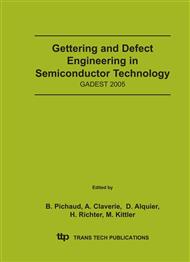p.469
p.477
p.483
p.489
p.497
p.503
p.509
p.515
p.519
The Role of Silicon Interstitials in the Formation of Boron-Oxygen Defects in Crystalline Silicon
Abstract:
Oxygen-rich crystalline silicon materials doped with boron are plagued by the presence of a well-known carrier-induced defect, usually triggered by illumination. Despite its importance in photovoltaic materials, the chemical make-up of the defect remains unclear. In this paper we examine whether the presence of excess silicon self-interstitials, introduced by ion-implantation, affects the formation of the defects under illumination. The results reveal that there is no discernible change in the carrier-induced defect concentration, although there is evidence for other defects caused by interactions between interstitials and oxygen. The insensitivity of the carrier-induced defect formation to the presence of silicon interstitials suggests that neither interstitials themselves, nor species heavily affected by their presence (such as interstitial boron), are likely to be involved in the defect structure, consistent with recent theoretical modelling.
Info:
Periodical:
Pages:
497-502
Citation:
Online since:
December 2005
Price:
Сopyright:
© 2005 Trans Tech Publications Ltd. All Rights Reserved
Share:
Citation:


